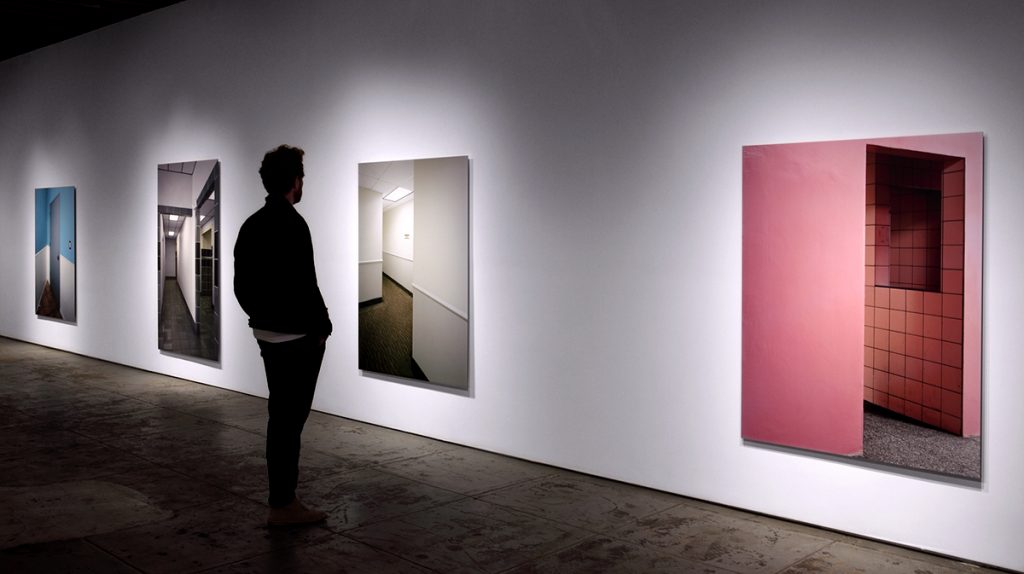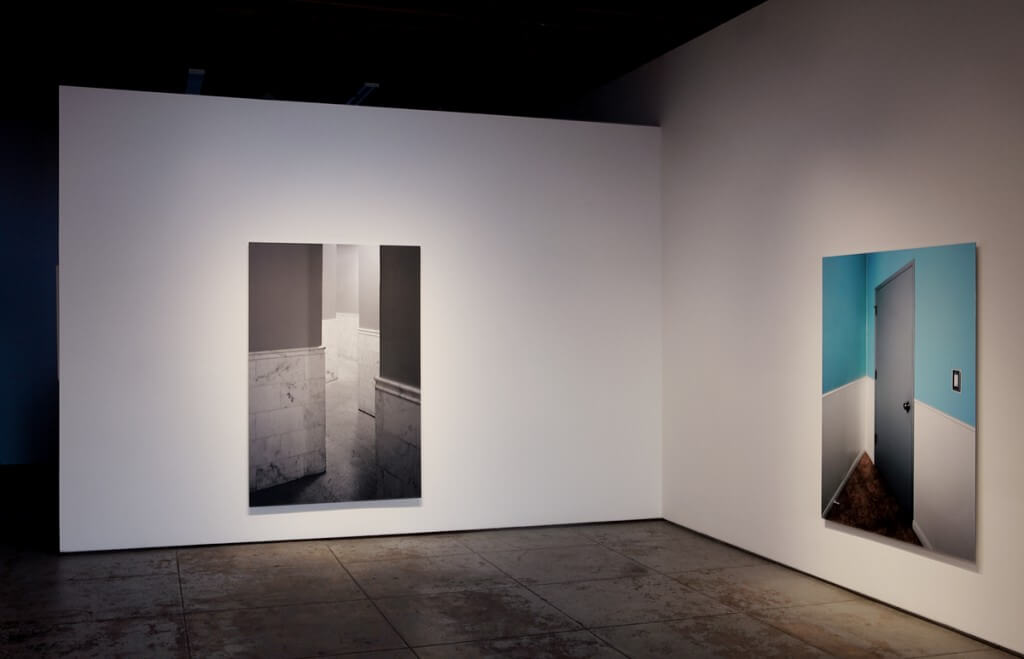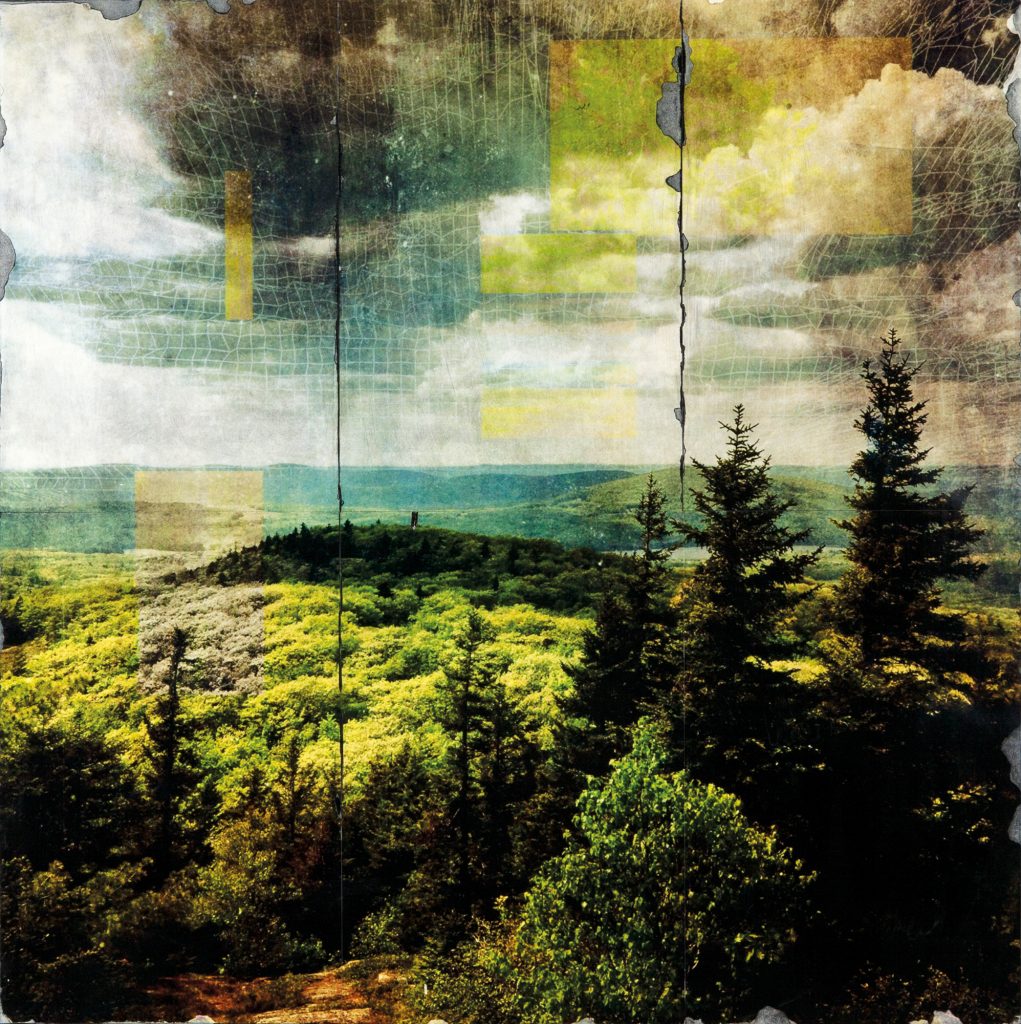Austin Irving: Not an Exit


Tell me about the group of photographs of NOT AN EXIT. When did you begin to capture the series and edit them into a cohesive show? Did you begin with a concept or did you have realizations along the way as far as color, form, and overall style?
I found the first image of my NOT AN EXIT series by accident. I was staying in a hotel in Souest, Netherlands in 2007 for a commercial assignment and late at night after a long day of shooting bridal gowns, I discovered that from one exact spot, the hotel hallway looked strangely and uncomfortably impassable. When I travel, I always bring my 4×5 camera with me, so I was able to capture this bizarre optical illusion on film. At the time, that image was an anomaly as I was primarily shooting portraits, landscapes and nightscapes. It wasn’t until I found another location in Singapore in 2009 that had the same qualities as that first image in Souest that I realized that this was going to become a series.

Since then, I have walked through countless hallways and doorways and I’ve found only a select few locations that, when viewed from one exact angle, illicit that same visceral reaction. Sometimes I wonder if they find me. There are several factors that elevate a space from a regular hallway or doorway to one that I’d like to photograph: the combination of materials used in the interior design, a serendipity of the colors existing in the space and the linear illusion that exists from a specific point.

You are a fine art photographer working in large format as well as freelance commercial photography. Your website is divided into people and places. What is your studio practice like and how do you spend time daily developing your interest in various subject matter?
My studio practice is multidisciplinary – in addition to scanning large format negatives and editing my files, I write electronic music, shoot and edit music videos for a side project entitled PG13. I find that working on multiple projects in different mediums makes it easier to keep the ball rolling. My commercial portfolio is a combination of my fine art work and commercial assignments, both 4×5 and digital. My fine art portfolio is exclusively 4×5 and where I focus the majority of my attention.
Describe the exhibition process for you. How did you interact with the space of the Wilding Cran Gallery and what decisions did you make in installing the work?
Working with Wilding Cran Gallery has been a dream come true. The curators understand my work and gave me a lot of freedom in both the edit and presentation of the series. It has always been my intention to show these images the size of hallway and doorways and to mount the pieces low to the ground as if the viewer could step right in the spaces. The gallery itself couldn’t be more perfect to show this body of work – I love the rawness of the space and how the design is so clean and simple.

NOT AN EXIT refers to the interiors of hallways depicted in the photographs in the series but also seems to be a meditation on the interior design of place. What do these photographs mean to you? Are there narratives behind each photograph or stories behind including each in the show? The combination of wall, floor, door, and lighting is minimalist and painterly. How did this strike you?
Yes, this work is absolutely a meditation on interior design – our concepts of human habitat is definitely a recurring theme throughout my work. I am drawn to the universality of these spaces – a hallway in Malaysia could just as easily be a hallway in Downtown Los Angeles, and vice-versa. I realized that I was interested in locations that were built for function and how, because of their utility and banality, these spaces are often overlooked.
This work has multiple meanings to me. It is rewarding to transform a seemingly uninteresting space into an evocative image with the use of my large format camera. The process of making these images is also extremely enjoyable; each image takes between 4 and 30 minutes to make which affords me some time to be alone in the space with my thoughts. Also, composing a large format image is a lot like a jigsaw puzzle because when you look through the lens, the image is upside-down and backwards. I often stop looking at the location I’m shooting as a hallway and reconsider my composition in terms of line, form and color. Once I find the perfect angle, it’s an incredibly satisfying feeling.
I have several other series that I’ve been working on for a number of years that I will continue to work on and show. In fact, this theme of the social construct of human habitat is a large part of one of my other photographic studies entitled SHOW CAVES.The objective of SHOW CAVES is to highlight the tension that exists between the staggering natural beauty of caves and the renovations people make in order to transform these spaces into spectacular tourist attractions. These caverns have been curated to cater to both the physical needs of sightseers as well as to our collective expectation of the fantasy of a cave.
My photographs explore the paradoxes of urbanity; are these additions acts of vandalism disrupting a delicate eco-system for the sake of commercial profit? Or do these human interventions draw attention to the preservation of caves and make hard-to-access natural wonders readily available for appreciation?I plan on exhibiting another series, WINDOWS, that I will present as large LED light boxes. With exposures ranging from 8 to 60 minutes, this work documents a slow leak of filtered light into a room even when the curtains are fully drawn or the shutters are closed tight.I’m also looking forward to developing my music project, PG13, and am working on putting out an EP with accompanying music videos.









Responses